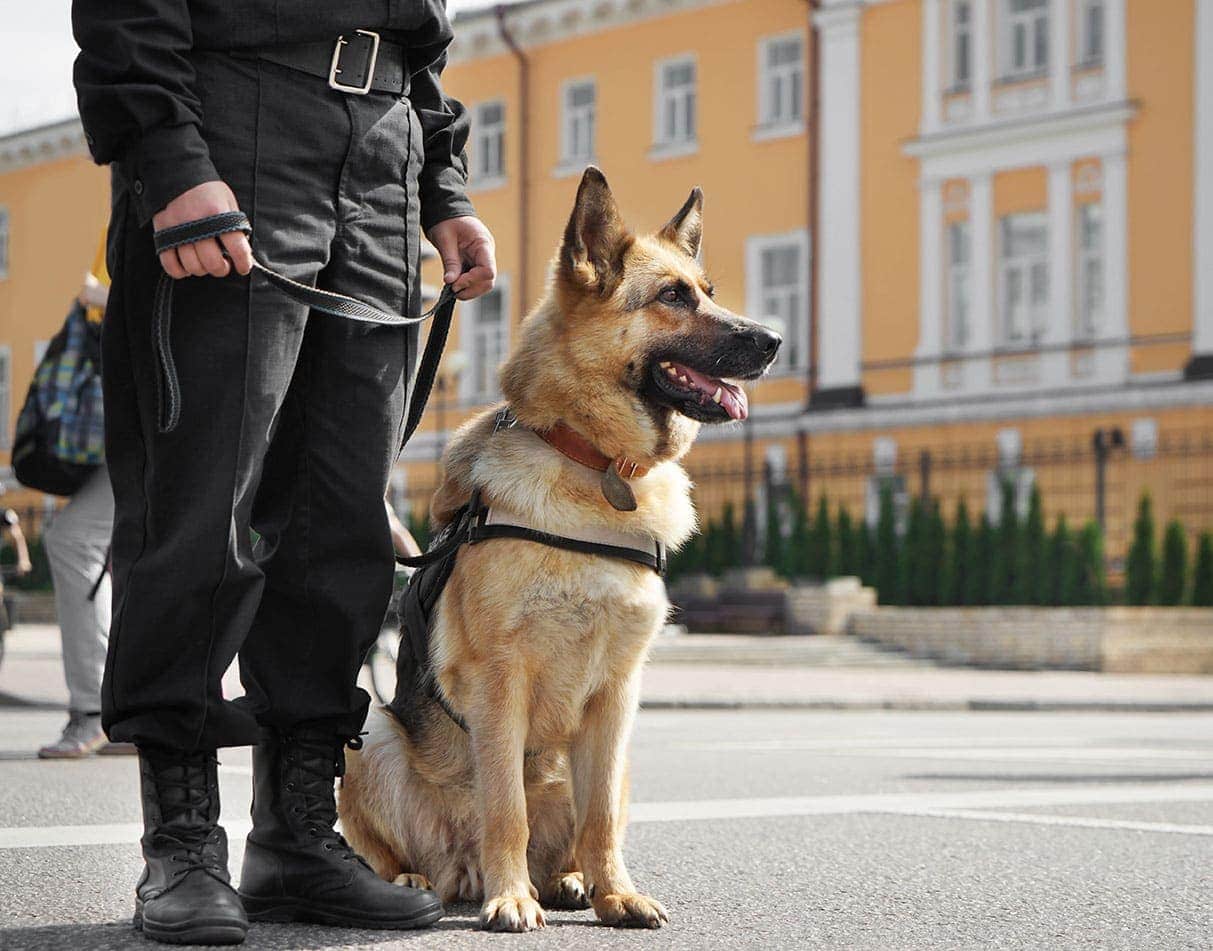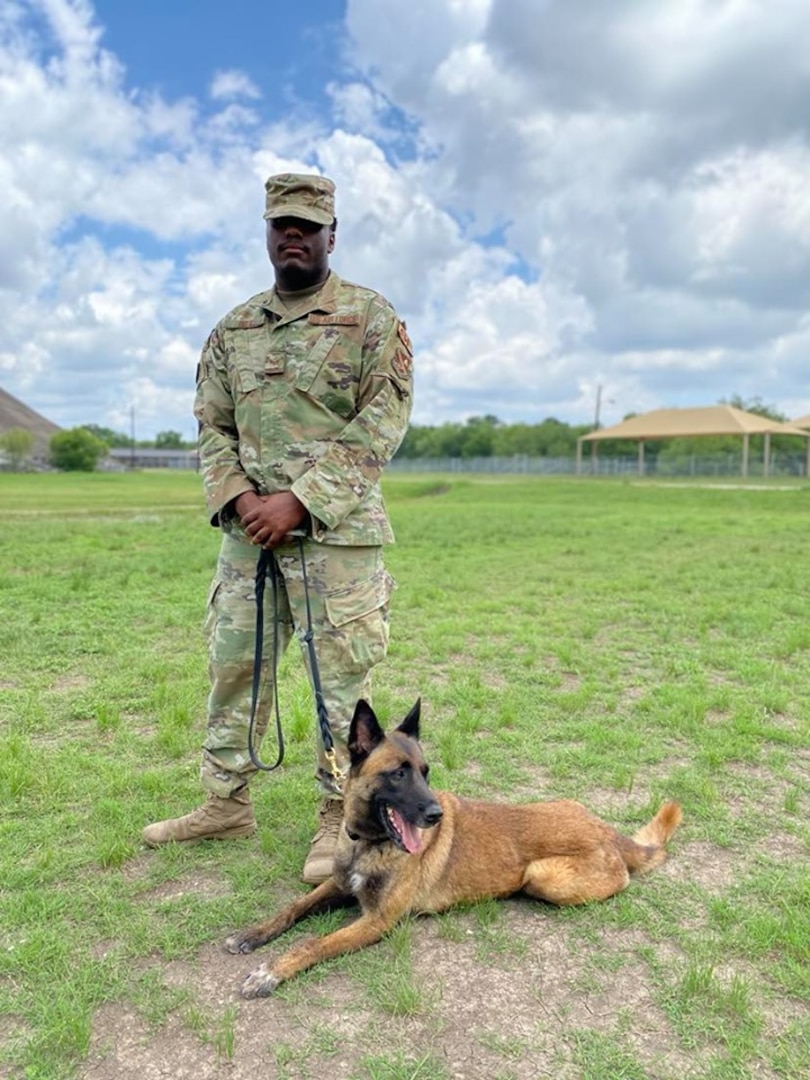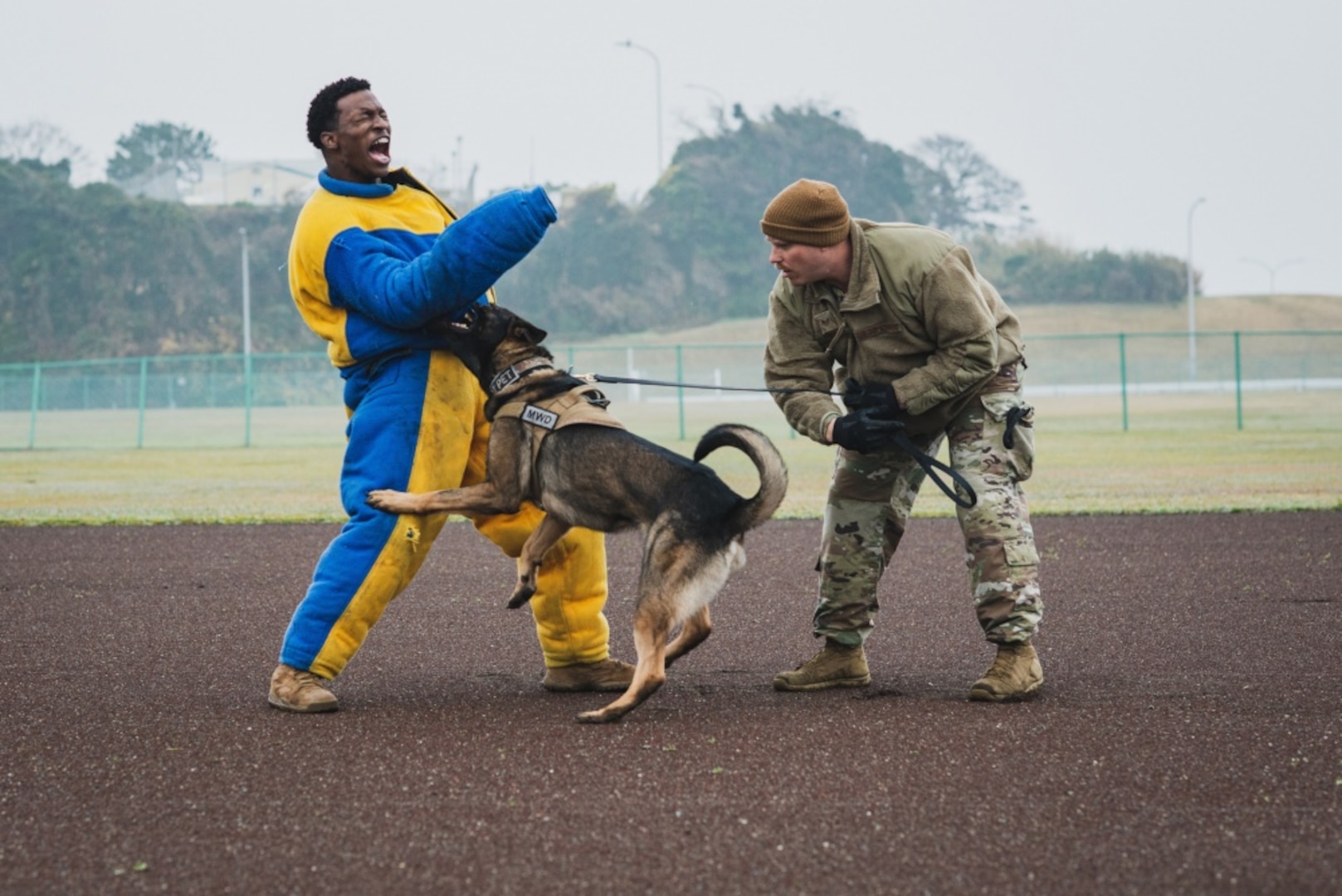Military Dog Commands - "It's going to take you a while for your dog to learn," said Dowling. "Some will learn quickly, some will learn slowly, but if you're consistent in rewarding them and how you give them commands and what your expectations are of them, then your dog will eventually pick that up, whether it's within days, weeks or
a month, whatever it is." Most MWD's that defecate in their kennels will simply wait for their handler to clean it up. Unfortunately, some MWD's like to play with it and spread it wherever they can.
Military Dog Commands
By the time the handler comes to clean it, the MWD has "painted" the kennel with feces. All handlers will learn how to decoy — aka pretend to be the bad guy — and it's important they know how to "agitate" properly to provoke the dog to bite them.
To do this they need to make noises and watching them scream and grunt for the first time can be hilarious. To make it simple, instructors tell beginning handlers to yell "HOT SAUCE!" very quickly over and over to provoke the dog.
When an MWD is trained to detect specific odors it will show a "change of behavior" when it encounters it. Handlers must get to know their dog's change of behavior so they know their MWD is about to find something.
This is ingrained in every handler's head. Dogs who become certified as military working dogs have gone through an extensive selection and training process. They have proven themselves to be the best at what they do.
Yet, with the bond a dog team creates and all the training they have gone through, handlers will, at times, doubt their dogs abilities. It's important to always remember to trust your dog because if there's anyone who is wrong, it's the handler because the dog is always right.
While training your dog can sound daunting, and after trying to convince my own dog that my bed is not in fact, her bed, or that squirrels are not plush chew toys she should eat, I realize that it's also sometimes frustrating.

"It starts when you feel the dog trusts you, and you have a good enough rapport and strong enough bond that they will listen to you, and there's really no timeframe for it," said Dowling. "It's really just dependent on you and your dog."
"To keep it positive, you find out what your dog likes as a reward, whether it's a kong or a toy," said Dowling, who adds that he would discourage food, because if you run out of treats, not only are you not
rewarding good behavior, you're not being consistent. It can be a little tricky to teach this command to your dogs. Dog Trick Academy explains that your dog needs to be in a submissive pose to perform this command.
Unfortunately, all dogs are not willing to do so, and some breeds can be extremely stubborn. This is a very important and useful command when your dog runs away from you to chase something. It is reasonably easy to teach this command.
However, you will need to put your dog on a leash for training the 'come' command. Take a treat and hold it close to your dog's nose. Once you have his/her attention, raise the treat by moving your hand upwards.
This will naturally cause your dog to sit on the floor. Once your dog is in a sitting position, say "sit" and give him/her the treat. Repeat this a few times, and your dog will learn to sit on command.
Military dogs are very athletic and can take down a man within a few seconds. Therefore, you must wear protective gloves (and gear) while training your dog to attack a target. Make sure that your pooch is familiar with the sit, stay, stand, and run commands before teaching this instruction.

"You don't want to train your dog in your living room, or a public crowded place," said Dowling. "You want to bring them into an environment where it can be just you and your dog. Whether it's in a park, or some place where you know you're going to have limited distractions.
Preferably in a fenced in area.” James Clark is the Deputy Editor of Task & Purpose and has been with the publication since 2015. He is an Afghanistan War veteran and served in the Marine Corps as a combat correspondent.
James is responsible for overseeing the daily news coverage of the editorial team, assigning stories, approving pitches, editing, and ensuring stories published on the site meet Task & Purpose's editorial standards and the audience's needs. Contact the author here.
To teach your dog this command, hold a treat that smells really good. Hide the treat inside your fist so your dog can smell it but cannot see it. Slowly move your hand down towards the floor while repeating the command ("down") to your dog.
You may have to slide your hand on the ground for your dog to follow it. In reality, whatever we train our dogs to do can be called anything at all. We can ask a dog to sit by using the word "egg" if we want to, as long as we have shown the dog what the word means.
Generally though the commands we teach to our dogs are far more sensible than "egg" When an MWD is released to bite, handlers want them to get a full mouth bite, clench tight, and hold on until the handler gets there so the suspect can't get away.
However, dogs that are not fully confident will not clench and hold and instead will bite, then release, and then bite a different area. MWDs that do this are known as typewriters. For some dog training tips, Task & Purpose reached out to Mike Dowling, a Marine veteran of the Iraq War, and a former military working dog handler.

Dowling also works with Hounds and Heroes, a nonprofit that provides service dogs to military veterans, and is the author of "Sergeant Rex: The Unbreakable Bond Between a Marine and His Military Working Dog." Most novice handlers unknowingly hold the leash up high while their dog is detecting making it look as though they are holding a purse.
It is unnatural, there's no reason for it, and typically it's a sign of the handler not being relaxed. Instructors will tell them to "drop the purse" so they lower the leash and assume a more relaxed hold of it.
Expert Security Tips describes a common way of teaching your dog the "attack" command. Wear a thick glove and tap your dog in the face. This will irritate the dog, causing him/her to bite the glove.
As soon as your pup bites the glove, repeat the word "attack" in a loud tone. If he/she starts attacking the glove on your command, give him/her treats and lots of verbal praise. Tell your dog to sit next to you and give him/her a treat.
Then, start moving slowly with treats held out in front. This will encourage your dog to walk right next to you. Repeat the command ("heel") and give your pup some treats when he/she follows your instructions.
"Everything spawns from obedience, because if they won't sit when you tell them to sit or heel when you tell them to heel, they won't do anything else," said Dowling. "In a human to human relationship they are equal.
In a human to dog relationship you're the alpha, and that's important because they rely on you for protection and guidance." These commands are not always aggressive because they are primarily used to discipline the dogs.

Dogs can't understand words and they learn by associating certain actions with specific sounds. For example, you can train a dog to chase people by using the word "bone". Read on to learn how you can train military dog training commands to your pooch.
Lower yourself so that you are at the same level as your dog. Gently pull on the leash to make your dog follow you while repeating the word "come". Never pull too hard on the leash because it can compromise the training and can also be dangerous.
When your dog starts following you, give him/her a treat. Repeat this exercise a few times to strengthen this behavior. When you command your dog to heel, he/she should walk beside you rather than strolling behind or in front.
It can be a difficult command to teach, so make sure you have lots of treats and patience. The method to teach your dog to jump is very similar to that of the 'sit' command. Take a treat in your hand and make sure your dog can smell it.
Slowly raise your hand until it is out of your dog's reach. If trained properly, dogs are one of the most obedient animals. They can perform various tasks, ranging from chasing intruders to finding lost people.
Canines are often used in the military and are taught several commands to execute the given instructions. Keep reading to know more about the most common military dog training commands. All military working dog (MWD) handlers — no matter what branch of service they are in, go through the same basic handlers course and advanced dog training schools.
As a result, all handlers in the military use key terms and phrases that every handler will understand. Here are the most common terms and what they mean. To conduct a proper detection search, all handlers are taught the "inverted V" method in which the dog detects low, then high, then low again.
To do this, handlers must learn to walk backwards and beginners move their feet so slowly it's known as the "Lackland shuffle" in reference to the basic handler's course at Lackland Air Force Base. Trick commands are great fun and can be used when reinforcing a wide range of impressive behaviors.
You can even teach your dog to respond to dog training commands uniquely in a completely different language. You dog will relate to the tone and pitch of your voice rather than the word itself. Then, slowly start moving away while repeating the word "stay".
If your dog stays in one place, give him/her another treat while repeating "stay". Keep moving away (a few steps) from your dog and include longer stays as the training progresses. Don't forget to give your dog a treat whenever he/she obeys your command and stays in the spot.
MWD's build up a lot of momentum when they run after the decoy. At the moment of impact it is important that the decoy is not so stiff to allow the dog's momentum to carry through.
If the decoy is too stiff, they can jam the dog which can potentially hurt them. The typical response from a handler whose dog was jammed is to ask the decoy if they want peanut butter.
By James Clark | Published Jan 29, 2016 10:00 AM EST No handler wants to hear "reverse." When doing detection with their MWD, if a handler hears "reverse" from the instructor, they know they missed the training aid and now must do the embarrassing action of backtracking.
Sometimes, a "not at source" or "pinpoint" is added when the instructor notices the dog is on the scent but hasn't found the training aid yet. "In a lot of ways a dog-human relationship is like a human-human relationship but with fewer words," said Dowling.
"The only key difference is that you want to make them feel like they're part of the pack."
advanced military dog commands, military dog training commands, military k9 commands, police dog commands, military working dog commands, military dog training, basic dog training commands printable, military dog training courses

